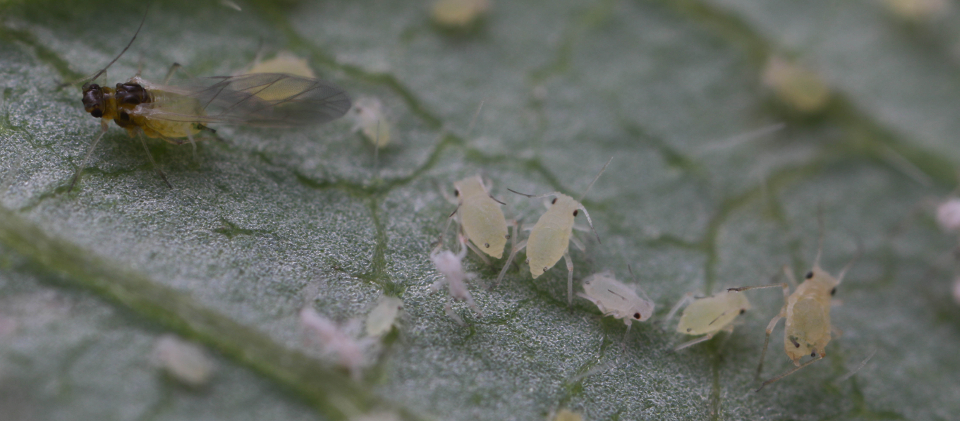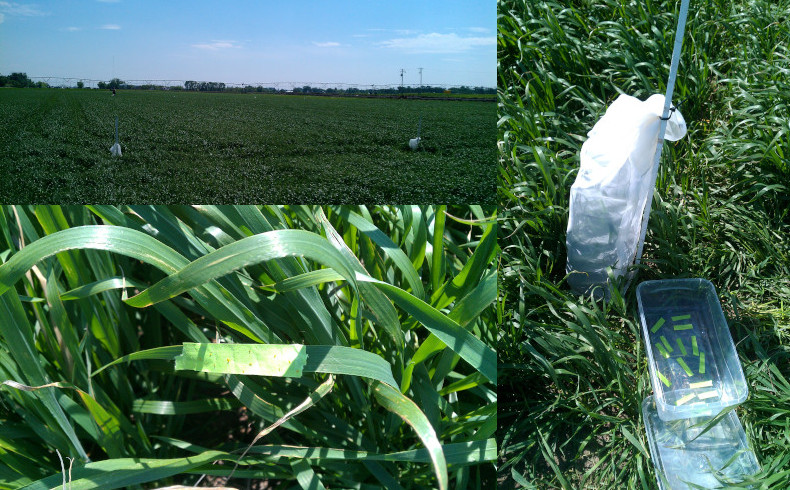
Photo Credit: Jordan Bannerman, University of Manitoba
Project 1: Soybean aphid suppression and natural enemy movement in agricultural landscapes in Manitoba
The soybean aphid, Aphis glycines Matsumura (Hemiptera: Aphididae), is a major invasive species in North America that causes significant yield losses in soybean production. Therefore, it is important to determine factors regulating soybean aphid populations in Manitoba to prevent and manage future outbreaks. The main goal of this study is to understand how landscape complexity affects the biological control of soybean aphids in Manitoba, particularly looking at effects on dispersal behaviour of transient aphidophagous predators between soybean fields and different neighbouring habitats.
Hypotheses
- Increasing landscape complexity should result in greater soybean aphid suppression via increased natural enemy populations and/or movement.
- Alternate habitats can act as either souces of sinks of transient aphidophagous natural enemies.

Project 2: Investigating the causes and consequences of wing development in soybean aphid
This project focuses on determining environmental factors that induce wing development in soybean aphid, as well as understanding how the production of winged individuals can affect colony level fitness under predation. Since apterous (wingless) and alate (winged) morphs have different ecological roles, the study of polyphenism is key understanding soybean aphid population dynamics.
Hypotheses
- As a result of adaptation to density-dependent effects, environmental cues such as crowding and changes in host-plant nutritional quality could act as cues that induce wing development in the soybean aphid.
- The fecundity costs associated with wing development in individual soybean aphids may be overcome by the potential benefits to colony level fitness in a system under predation.
Photo credit: Alicia Leroux
Project 3: Sampling and quantifying the effect of natural enemies on soybean aphid
This project focuses on two related topics: (1) determining which natural enemies are capable of causing significant levels of soybean aphid suppression before their populations reach outbreak levels, and (2) determining which sampling methods are best suited for precise but efficient assessment of those important soybean natural enemies. Ultimately, this information can be used to improve economic decision making in soybean in North America via incorporation of natural enemy information into economic thresholds.
Hypotheses
- Harmonia axyridis (Coleoptera: Coccinellidae) and Orius insidiosus (Hemiptera: Anthocoridae) are the two most impactful species in terms of soybean aphid suppression in North America.
- Sampling methods will vary in their ability to accurately detect the assemblage of natural enemies in soybean due to differences in species mobility, size and densities.

Photo Credit: John Gavloski, Manitoba Agriculture, Food and Rural Development
Project: Effects of landscape structure on abundance of Cereal Leaf Beetle and its natural enemies
This project seeks to increase our understanding of how landscape structure can influence parasitism of the cereal leaf beetle by the parasitoid Tetrastichus julis. Furthermore, this work seeks to determine how habitat complexity influences the diversity and abundance of generalist predators in agricultural ecosystems.
Hypotheses
- Cereal leaf beetle parasitsim rates will differ based on the extent and arrangement of non-crop habitats in an agricultural landscape.
- Habitats with a higher proportion of non-crop or semi-natural habitats will harbour a greater diversity of generalist predators.

Photo credit: Arash Kheirodin
